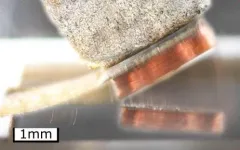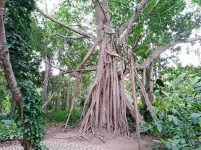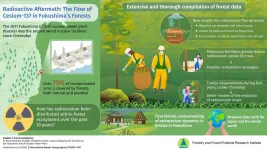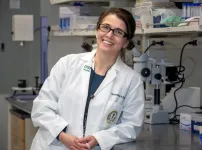From waste heat to electrical power: A new generation of thermomagnetic generators
Alloy film thickness and footprint influence electrical power -- publication in Joule
2021-02-03
(Press-News.org) Use of waste heat contributes largely to sustainable energy supply. Scientists of Karlsruhe Institute of Technology (KIT) and T?hoku University in Japan have now come much closer to their goal of converting waste heat into electrical power at small temperature differences. As reported in Joule, electrical power per footprint of thermomagnetic generators based on Heusler alloy films has been increased by a factor of 3.4. (DOI: 10.1016/j.joule.2020.10.019)
Many technical processes only use part of the energy consumed. The remaining fraction leaves the system in the form of waste heat. Frequently, this heat is released into the environment unused. However, it can also be used for heat supply or power generation. The higher the temperature of the waste heat is, the easier and cheaper is its reuse. Thermoelectric generators can use waste heat of low temperature for direct conversion into electrical power. Thermoelectric materials used so far, however, have been expensive and sometimes even toxic. Moreover, thermoelectric generators require large temperature differences for reaching efficiencies of just a few percent.
Thermomagnetic generators represent a promising alternative. They are based on alloys, whose magnetic properties are highly temperature-dependent. Alternating magnetization induces an electrical voltage in a coil applied. Researchers presented first concepts of thermomagnetic generators in the 19th century already. Since then, research has covered a variety of materials. Electrical power, however, has left a lot to be desired.
Scientists of KIT's Institute of Microstructure Technology (IMT) and T?hoku University in Japan have now succeeded in largely increasing the electrical power per footprint of thermomagnetic generators. "Based on the results of our work, thermomagnetic generators are now competitive with established thermoelectric generators for the first time. With this, we have come a lot closer to the goal of converting waste heat into electrical power at small temperature differences," says Professor Manfred Kohl, Head of the Smart Materials and Devices Group of IMT. Work of the team is reported in the cover story of the latest issue of Joule.
Vision: Recovery of Waste Heat Close to Room Temperature
So-called Heusler alloys - magnetic intermetallic compounds - are applied in the form of thin films in thermomagnetic generators and provide for a big temperature-dependent change of magnetization and quick heat transfer. This is the basis of the new concept of resonant self-actuation. Even at small temperature differences, resonant vibrations are induced in devices and can be converted efficiently into electrical power. Still, electrical power of single devices is low and upscaling will depend on material development and engineering. The researchers of KIT and T?hoku University used a nickel-manganese-gallium alloy and found that alloy film thickness and the device footprint influence electrical power in opposite directions. Based on this finding, they succeeded in improving electrical power per footprint by a factor of 3.4 by increasing the thickness of the alloy film from five to 40 micrometers. The thermomagnetic generators reached a maximum electrical power of 50 microwatts per square centimeter at a temperature change of just three degrees Celsius. "These results pave the way to the development of customized thermomagnetic generators connected in parallel for potential use of waste heat close to room temperature," Kohl explains. (or)
INFORMATION:
Original Publication
Joel Joseph, Makoto Ohtsuka, Hiroyuki Miki, and Manfred Kohl: Upscaling of Thermomagnetic Generators Based on Heusler Alloy Films. Joule, 2020. DOI: 10.1016/j.joule.2020.10.019
To the Publication in Joule (Abstract): https://www.cell.com/joule/fulltext/S2542-4351(20)30508-0
More about the KIT Energy Center: https://www.energie.kit.edu
Contact for this press release: Martin Heidelberger, Press Officer, Phone: +49 721 608-41169, martin.heidelberger@kit.edu
Being "The Research University in the Helmholtz Association", KIT creates and imparts knowledge for the society and the environment. It is the objective to make significant contributions to the global challenges in the fields of energy, mobility, and information. For this, about 9,300 employees cooperate in a broad range of disciplines in natural sciences, engineering sciences, economics, and the humanities and social sciences. KIT prepares its 24,400 students for responsible tasks in society, industry, and science by offering research-based study programs. Innovation efforts at KIT build a bridge between important scientific findings and their application for the benefit of society, economic prosperity, and the preservation of our natural basis of life. KIT is one of the German universities of excellence.
[Attachments] See images for this press release:

ELSE PRESS RELEASES FROM THIS DATE:
2021-02-03
In the race to stop the spread of COVID-19, a three-layer cloth mask that fits well can effectively filter COVID particles, says a group of UBC researchers.
After testing several different mask styles and 41 types of fabrics, they found that a mask consisting of two layers of low-thread-count quilting cotton plus a three-ply dried baby wipe filter was as effective as a commercial non-surgical mask at stopping particles--and almost as breathable.
The cloth masks filtered out up to 80 per cent of 3-micron particles, and more than 90 per cent of 10-micron particles.
"We focused on particles larger than one micron because these are likely most important to COVID-19 transmission," explains researcher Dr. Steven Rogak, a professor of mechanical engineering who ...
2021-02-03
The genus Ficus (figs) and their agaonid pollinating fig wasps are a classic example of coevolution. It represents perhaps the most extreme and ancient (about 75 million years) obligate pollination mutualism known.
Previous studies have suggested that pollinator host-switching and hybridization existed in some fig taxa with genetic evidence based on relatively few genes. However, those cases were mainly treated as rare exceptions, and strict-sense coevolution was still treated as the dominate coevolution model for the codiversification of this "extreme" obligate pollination system with high species richness.
Together with colleagues from 11 institutions from home and abroad, researchers from the Xishuangbanna Tropical Botanical ...
2021-02-03
Scientists at Scripps Research have clarified the workings of a mysterious protein called Gαo, which is one of the most abundant proteins in the brain and, when mutated, causes severe movement disorders.
The findings, which appear in Cell Reports, are an advance in the basic understanding of how the brain controls muscles and could lead to treatments for children born with Gαo-mutation movement disorders. Such conditions--known as GNAO1-related neurodevelopmental disorders--were discovered only in the past decade, and are thought to affect at least hundreds of children around the world. Children with the disease suffer from severe developmental ...
2021-02-03
World-first 3D printed oesophageal stents developed by the University of South Australia could revolutionise the delivery of chemotherapy drugs to provide more accurate, effective and personalised treatment for patients with oesophageal cancer.
Fabricated from polyurethane filament and incorporating the chemotherapy drug 5-fluorouracil (5-FU), the new oesophageal stents are the first to contain active pharmaceutical ingredients within their matrix .
Their unique composition allows them to deliver up to 110 days of a sustained anti-cancer medication directly to the cancer site, restricting further tumour growth.
Importantly, the capabilities of 3D printing enabling rapid creation of individually tailored stents with patient-specific geometries and drug dosages.
PhD ...
2021-02-03
The COVID-19 pandemic is a great example of the importance of access to the Internet and to digital health information. Unfortunately, historical disparities in health care appear to be reflected in computer ownership, access to the Internet and use of digital health information. However, few studies have qualitatively explored reasons for digital health information disparity, especially in older adults.
A study led by Florida Atlantic University's Christine E. Lynn College of Nursing in collaboration with the Dana-Farber Cancer Institute and the University of Massachusetts Medical ...
2021-02-03
A 30-year high in East African rainfall during 2018 and 2019 resulted in rising water levels and widespread flooding. The new study shows that emissions of methane - the second most important greenhouse gas - from flooded East African wetlands were substantially larger following these extreme rainfall events.
The study, led by Dr Mark Lunt from the University of Edinburgh's School of GeoSciences, used data from two different satellites in combination with an atmospheric model to evaluate methane emissions from East Africa. This included data from the European TROPOMI satellite instrument, launched in 2017, which provides information about atmospheric methane at ...
2021-02-03
A new technique has taken the first images of muon particle beams. Nagoya University scientists designed the imaging technique with colleagues in Osaka University and KEK, Japan and describe it in the journal Scientific Reports. They plan to use it to assess the quality of these beams, which are being used more and more in advanced imaging applications.
Muons are charged particles that are 207 times the mass of electrons. They naturally form when cosmic rays strike atoms in the upper atmosphere, showering down onto every part of Earth's surface. They can penetrate through hundreds of meters of solids before being absorbed.
Scientists have used naturally ...
2021-02-03
Tsukuba, Japan - Although exercise is known to enhance cognitive function and improve mental health, the neurological mechanisms of this link are unknown. Now, researchers from Japan have found evidence of the missing link between aerobic fitness and cognitive function.
In a study published in Medicine & Science in Sports & Exercise, researchers from the University of Tsukuba revealed that spontaneous eye blink rate (sEBR), which reflects activity of the dopamine system, could be used to understand the connection between cognitive function and aerobic fitness.
The dopaminergic system is known to be involved in physical activity and exercise, and previous researchers have proposed that exercise-induced changes in cognitive function might be mediated by activity ...
2021-02-03
After the Chernobyl disaster of 1986, the 2011 Fukushima Daiichi nuclear power plant (FDNPP) disaster was the second worst nuclear incident in history. Its consequences were tremendous for the Japanese people and now, almost a decade later, they can still be felt both there and in the rest of the world. One of the main consequences of the event is the release of large amounts of cesium-137 (137Cs)--a radioactive "isotope" of cesium--into the atmosphere, which spread farther away from the power plant through wind and rainfall.
Considering the massive threat posed by 137Cs to the health of both humans and ecosystems, it is essential to understand how it has distributed and how much of it still lingers. This is why the ...
2021-02-03
Tampa, FL (Feb. 3, 2021) -- A preclinical study by a END ...
LAST 30 PRESS RELEASES:
[Press-News.org] From waste heat to electrical power: A new generation of thermomagnetic generators
Alloy film thickness and footprint influence electrical power -- publication in Joule








